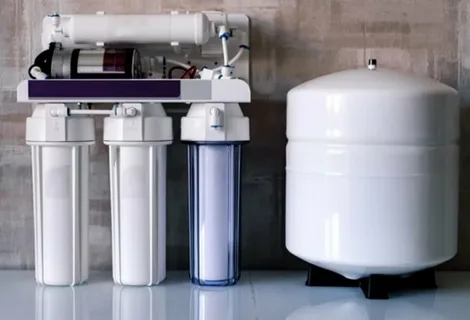Water is essential for life, and having access to clean, safe drinking water should never be compromised. Yet, with increasing concerns about contaminants in our tap water—ranging from chlorine to heavy metals—the need for reliable water filter for home has surged. Enter under-sink and countertop water filters, two popular solutions designed to enhance your home’s water quality.
Imagine sipping pure, refreshing water straight from your kitchen without the worry of hidden pollutants. Whether you want to improve taste or safeguard your health, these filtration options can significantly impact your daily routine. Let’s dive into home water filters and explore how they can elevate hydration at home!
Types Of House Water Filter:
Two popular options for home water filtration stand out: under-sink filters and countertop filters. Each type has unique features that cater to different needs.
A. Under-Sink Filters
Under-sink filters are a popular choice for many households. Hidden beneath your kitchen counter, they offer a sleek solution to water purification without taking up valuable space.
House water filter typically connect directly to your existing plumbing. They filter out impurities as water flows through, providing clean drinking water straight from the tap.
One of the main advantages of under-sink filters is their efficiency. They can remove a wide range of contaminants, including chlorine, lead, and sediment. This means you get better-tasting water while protecting your health.
However, installation can be complex and may require professional help. Additionally, some models need regular maintenance or cartridge replacements to be maintained optimally.
Despite these drawbacks, many homeowners find under-sink filters worth it for their convenience and quality of daily life.
I. Pros and Cons
Under-sink filters offer several advantages. They save countertop space by being installed out of sight. Many models effectively remove contaminants and provide cleaner water for cooking and drinking. However, these systems can come with drawbacks. Installation requires some plumbing knowledge, which may deter DIY enthusiasts. Additionally, they often have a higher upfront cost compared to other options.
Countertop filters are easy to set up; most must be placed on the counter and connected to the faucet. They also tend to be more affordable initially while improving water quality significantly. Yet, they do take up valuable counter space and can be less aesthetically pleasing. Some users find them inconvenient if multiple pitchers or containers are needed for daily hydration. Each type has unique appeal and potential limitations based on personal preferences and lifestyle choices.
B. Countertop Filters
Countertop filters are an increasingly popular choice for households seeking clean drinking water. These systems sit conveniently on your kitchen counter and connect easily to the faucet. One of their key advantages is portability. If you move, you can take it with you without much hassle. They also often have a higher filtration capacity than some smaller units, which means they can effectively handle larger volumes of water.
However, there are downsides to consider. Countertop models can occupy valuable counter space, which might be a concern in smaller kitchens. Additionally, depending on usage and water quality, they may require more frequent filter replacements. Despite these drawbacks, many find that the convenience and immediate access to purified water make countertop filters appealing for enhancing home hydration. The balance between usability and efficiency makes them noteworthy contenders for in-home filtration solutions.
I. Pros and Cons
Under-sink filters offer a seamless solution for your home’s water needs. They are installed discreetly, saving valuable counter space. You get high-quality filtered water right from the tap.
On the downside, installation can be more complex than you might expect. Some homeowners may need professional help, which can increase initial costs.
Countertop filters are user-friendly and easy to set up. They require no special tools and can be moved easily if needed. This flexibility is appealing to renters or those who relocate often.
However, they occupy counter space that could be used for other items. Plus, some models may not filter as thoroughly as under-sink options.
Each type has distinct advantages and drawbacks before deciding which is best for your household’s needs.
Factors To Consider When Choosing A Water Purifier For Home
Choosing the right water purifier for home involves several important considerations. Start with assessing your water quality. Test your tap water to identify contaminants that need removal. Knowing what’s in your water helps narrow down options.
A. Water Quality
Water quality is a primary factor in choosing the right filter for your home. It varies significantly based on geographical location and plumbing materials. Understanding what’s in your water supply can guide you toward an effective filtration solution. Testing your water is essential. Home test kits are available to check for contaminants like lead, chlorine, or bacteria. Depending on the results, you may need a specific type of filter to effectively target those impurities.
Municipal water supplies often have standards different from those of healthy water. The latter might contain more minerals or biological elements that require robust filtration systems. Consider also how hard or soft your water is; this affects not just taste but appliance longevity, too. A comprehensive analysis sets the foundation for better decision-making regarding filtration options tailored to meet specific needs at home.
B. Budget
Budget plays a key role when choosing a water filter. It’s essential to determine how much you’re willing to invest upfront.
Under-sink filters often have higher initial costs but can save money over time by reducing bottled water purchases. On the other hand, countertop models usually have a lower price point.
Remember that some filters require replacement cartridges or regular maintenance, which adds ongoing expenses. Therefore, it is wise to look beyond the purchase price and consider long-term costs.
There are affordable options available that still deliver quality filtration. Do your research on features and reviews before making a decision.
Balancing quality with cost ensures you find the right fit for your home without breaking the bank. Prioritize what matters most – clean water shouldn’t be an afterthought or luxury.
C. Maintenance
Maintenance is a critical factor when choosing a water filter. Regular upkeep ensures that your system operates efficiently and consistently delivers clean water.
For under-sink filters, this often involves changing cartridges every six months to two years, depending on usage and manufacturer guidelines. Keeping track of these replacements is essential to avoid any performance drop.
Countertop filters might require less frequent maintenance but still need attention. Cleaning the unit regularly helps prevent buildup and ensures optimal flow rates.
Many modern systems come with reminder indicators or easy-access designs for hassle-free maintenance. Always consult the user manual for specific care instructions tailored to your model.
A well-maintained filter improves taste and prolongs its lifespan, saving you money in the long run. Please keep it simple; set reminders and stick to a routine for peace of mind regarding your drinking water quality.
Affordable & Efficient Water Filters for Home Use
Finding an affordable water filter doesn’t mean sacrificing quality. Many options in the market provide effective filtration without breaking the bank.
Look for models that combine both affordability and efficiency. Some under-sink systems offer advanced filtration at a lower cost than expected. They remove impurities while being easy to install and maintain.
Countertop filters can also be budget-friendly, giving you flexibility in your kitchen setup. These units can purify water quickly, making them perfect for families on the go.
Consider multipurpose filters that tackle different contaminants simultaneously. This versatility ensures clean drinking water straight from your tap.
Researching user reviews is essential, too. Real-life experiences give insight into performance and longevity, helping you make informed decisions while sticking to your budget.
Conclusion
Understanding what each type offers helps in making an informed choice. Each system has its unique advantages, catering to various needs. The importance of clean water cannot be overstated. It contributes to better health and enhances daily living experiences. As you explore filtration solutions, consider maintenance requirements and budget constraints. These aspects play a crucial role in long-term satisfaction with your chosen system. Investing in efficient water filter for home is a step towards ensuring safe hydration for you and your family. Explore eco-friendly options, too; they benefit you and benefit not only you but the environment around you.
FAQs
1. What is the difference between under-sink and countertop water filter for home?
Under-sink filters are installed beneath your kitchen sink, providing a dedicated faucet for filtered water without taking up counter space. Countertop models sit on the counter and connect to your faucet but can be more visible in the kitchen.
2. How often should I replace my water filter?
Replacement frequency depends on the type of filter and usage levels. Generally, most under-sink systems need replacement every 6-12 months, while countertop filters may last longer depending on their design.
3. Are there eco-friendly options available?
Yes! Many brands now offer eco-friendly filtration solutions that reduce plastic waste through reusable containers or compostable materials, making them an excellent choice for environmentally conscious consumers. Choosing the right water filter enhances your health and contributes to your home’s environmental sustainability.



